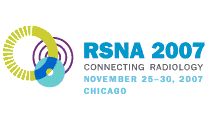
Abstract Archives of the RSNA, 2007
Christian R. Habermann MD, Presenter: Nothing to Disclose
Thorsten Ries MD, Abstract Co-Author: Nothing to Disclose
Joachim Graessner MS, Abstract Co-Author: Employee, Siemens AG
Katja Nelting MD, Abstract Co-Author: Nothing to Disclose
Julia Scheel MD, Abstract Co-Author: Nothing to Disclose
Gerhard B. Adam MD, Abstract Co-Author: Nothing to Disclose
To evaluate the influence of different oral stimulation methods of measuring different functional conditions of parotid glands using diffusion-weighted (DW) echo-planar imaging (EPI).
Twelve healthy volunteers were examined with a DW EPI sequence using a 1.5 T system (b factors: 0, 500, and 1,000 sec/mm2) once prior and 17 times after oral stimulation. Volunteers were prospectively randomized in two groups and examined three times. Group A was stimulated for first and third examination with 5 cc of a commercially available lemon juice, and secondly with a 500 mg tablet of ascorbic acid. Group B was stimulated at first and third examination with ascorbic acid, and secondly with lemon juice. ADC maps were transferred to MRIcro and evaluated with a manually placed region of interest (ROI) containing the entire gland. Measurements were performed by two independent observers. For evaluation of interobserver variability an intraclass correlation was computed. For further comparison, the Student’s t test, and an ANOVA with post hoc comparison were used.
The intraclass correlations were calculated between .96 and .99 for all measurements. The mean value for all volunteers prior to stimulation with lemon juice was 1.09 x 10 -3 mm 2 /sec (SD ± .08) and 1.1 x 10 -3 mm 2 /sec (± .09) prior to stimulation with ascorbic acid. In all volunteers first measurement after stimulation showed an increase of ADC. The ADC after stimulation with ascorbic acid (1.21 x 10 -3 mm 2 /sec ± .11) proofed to be significant higher compared to stimulation with lemon juice (1.17 x 10 -3 mm 2 /sec ± .12; p= .005). Over 14 measurements ADC decreased stepwise to the initial ADC value for both stimulation methods. Both groups showed no statistical significance between first and third examination (p=0.53 to .99).
DW EPI imaging displays functional changes in parotid glands with high reproducibility. The stimulation method has an influence on the extent of ADC changes, but not on the course.
Functional imaging based on DW EPI imaging can possibly replace salivary gland scintigraphy.
Habermann, C,
Ries, T,
Graessner, J,
Nelting, K,
Scheel, J,
Adam, G,
Functional Imaging of Parotid Glands Using Diffusion-weighted Echo Planar MRI: Evaluation of Different Stimulation Methods. Radiological Society of North America 2007 Scientific Assembly and Annual Meeting, November 25 - November 30, 2007 ,Chicago IL.
http://archive.rsna.org/2007/5003270.html

